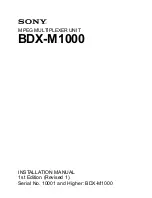
MX-2100/2104
Installation and Operation Manual
Chapter 2 Installation
Equipment Needed
2-9
The user can select, for each port, the data rate (9.6, 19.2, 38.4, 57.6 kbps), and
the word format (number of data bits, parity type, and number of stop bits). The
default communication data rate is 9.6 kbps. The default word format consists of
one start bit, eight data bits, no parity, and one stop bit.
The SP (CONTROL-DCE) supervisory port continuously monitors the incoming
data stream and will immediately respond to any input string received through this
port.
Connection of Supervision Terminal
A supervision terminal can be connected either directly to the MX-2100 SP
(CONTROL-DCE) supervisory port, or through a modem or any other type of
full-duplex data link. MX-2100 supports only a dial-in connection.
Handshaking Protocol - CONTROL DCE Port
The handshaking between MX-2100 and the equipment connected to it
(supervision terminal, SNMP management station, modem, etc.) uses the control
lines in the MX-2100 SP connector.
The control lines being used in the DCE and DTE interfacing mode, and the
direction of the control signals, are detailed in the following chart.
Table 2-3. DCE and DTE Interfacing Mode - Control Lines
Interface Type
Control Line
DCE DTE
CTS Out Not
used
DCD Out Out
DSR Out Out
DTR In In
RI Not
used
In
RTS In In
Data Terminal Ready (DTR)
The equipment connected to the SP port must set the DTR line ON (active) to gain
control over MX-2100 and start a management session. When the DTR is ON, the
MX-2100 front panel controls are disabled, and the LCD shows:
TERMINAL ON
LINE
.
To end the current session, the DTR line is switched OFF (inactive). This ends the
control connection, and returns the control to the MX-2100 front panel. If
password protection is used, the password must be entered again the next time the
DTR line is switched ON to start a new session.
Request to Send (RTS)
The RTS line is normally ON (active) during a management session.
When the RTS line is OFF (inactive), MX-2100 interprets any data received from
the terminal on the TD line as MARK.
















































